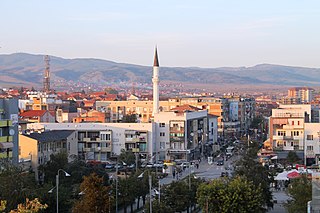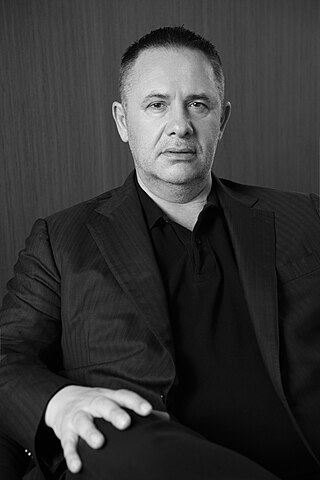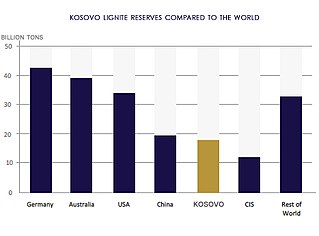
Gjakova or Đakovica is the seventh largest city of Kosovo and seat of Gjakova Municipality and Gjakova District. The city has 40,827 inhabitants, while the municipality has 94,556 inhabitants.

Gjilan or Gnjilane is the sixth most populous city in Kosovo and it serves as both a municipality and the administrative center of the Gjilan District. The municipality has a population of 90,178 with approximately 54,239 inhabitants residing in the urban area.

Kosovo Polje or Fushë Kosova, is a town and municipality located in the District of Pristina in Kosovo. According to the 2011 census, the town of Kosovo Polje has 12,919 inhabitants, while the municipality has 33,977 inhabitants.

Podujevo or Besianë is a city and municipality in the Pristina District in Kosovo. According to the 2011 census, the city of Podujevo has 23,453 inhabitants, while the municipality has 71,018 inhabitants in 2024 census. Podujevo is the largest municipality of Kosovo since it covers 632.59 km2 (244 sq mi) and is located along a regional motorway and also has railroad passing through it, which links the area to surrounding regions. Pristina, the capital of Kosovo, is located some 23 km (14 mi) to the south.

Vushtrri is a city and municipality located in the Mitrovica District in Kosovo. According to the 2011 census, the town of Vushtrri has 26,964 inhabitants, while the municipality has 69,870 inhabitants. Vushtrri is surrounded by the city of Mitrovica to the north, Podujevo in the east, Obiliq in the south, Drenas in the south-west, and Skenderaj in the west. The municipality of Vushtrri has 67 villages.
Obiliq is a town and municipality in Kosovo. According to the Kosovo Agency of Statistics (KAS) estimate from the 2011 census, there were 21,549 people residing in Obiliq Municipality, with Kosovo Albanians constituting the majority of the population.

Malisheva is a town and municipality in Kosovo. According to the Kosovo Agency of Statistics (KAS) estimate from the 2011 census, there were 54,613 people residing in Malisheva Municipality, with Kosovo Albanians constituting the majority of the population.

Drenica, also known as the Drenica Valley, is a hilly region in central Kosovo, covering roughly around 700 square kilometres (270 sq mi) of Kosovo's total area (6%). It consists of two municipalities, Drenas and Skenderaj, and several villages in Klina, Zubin Potok, Mitrovica and Vushtrri. It is located west of the capital, Pristina.

Skenderaj or Srbica is a town and municipality located in the Mitrovica District of Kosovo. According to the 2021 census, the municipality of Skënderaj has 52,586 inhabitants.

FC Vushtrria is a football club based in Vushtrri, Kosovo. The club was founded in 1922, and currently play their home games at the 7,000 seat capacity Ferki Aliu Stadium in the city of Vushtrri. Notable players to have played for the club include former Albania internationals Armend Dallku, Ahmed Januzi and Kosovo international Milot Rashica.

The Drenica massacres were a series of killings of Kosovo Albanian civilians committed by Serbian special police forces[a] in the Drenica region of central Kosovo.

Samir Mane ; born 24 December 1967 is an Albanian entrepreneur. He is the founder and President of Balfin Group, an investment group based in the Western Balkans. The group encompasses over 50 companies and operates in 10 countries across Europe and USA. Total Group’s Assets up to now €2.1 billion, as per 2022 data.

FC Feronikeli 74, commonly referred to as Feronikeli 74 and also known as Feronikeli is a professional football club based in Drenas, Kosovo. The club play in the Football Superleague of Kosovo, which is the top tier of football in the country.
Xhevdet Shabani is a Kosovar former professional footballer who played as a midfielder. He is nicknamed as "Rrapa".
Rexhep Rexhepi is a multi-purpose stadium in Glogovac, Kosovo. The ground serves as the home ground of KF Feronikeli.
Ahmet Haliti is a Kosovo Albanian professional footballer who plays as a defender for Kosovan club Feronikeli.
The 2015–16 Football Superleague of Kosovo was the 17th season of football in Kosovo. The season began on 22 August 2015 and ended on 22 May 2016; the relegation play-offs were on 1/2 June 2016. Feronikeli were the defending champions.
Mentor Zhdrella is a Kosovan professional football official and a former midfielder. He is the sporting director for Llapi. He has been hailed as one of Kosovo's greatest talent, having been named four times as Footballer of the Year of Kosovo, in 2009, 2010, 2011 and 2012. Mentor Zhdrella is known for his pace, dribbling and his speciality is free kicks.

The 2021–22 Football Superleague of Kosovo season, also known as the BKT Superleague of Kosovo for sponsorship reasons with Banka Kombëtare Tregtare was the 23rd season of top-tier football in Kosovo. The season began on 21 August 2021 and ended on 22 May 2022. A total of 10 teams are competing in the league: seven teams from the 2020–21 season and three teams from the 2020–21 First Football League of Kosovo. Prishtina are the defending champions from the previous season.

Lignite coal in Kosovo is and will continue to be an important local energy source due to its high reserves. Kosovo is very rich in lignite and accounts around 90% of Kosovo's electricity production. The nation has the 5th largest lignite reserves in the world and the 3rd in Europe. The lignite is distributed across the Kosovo, Dukagjin and Drenica Basins, although mining has so far been restricted to the Kosovo Basin. The lignite is of high quality for the generation of electricity and compares well with the lignite resources of neighbouring countries on a range of parameters. Kosovo's lignite varies in net calorific value from 6.28-9.21 MJ/kg, averaging 7.8 MJ/kg. The deposits can be up to 100 m thick, but average 40 m, and possess an average strip ratio of 1.7:1.


















